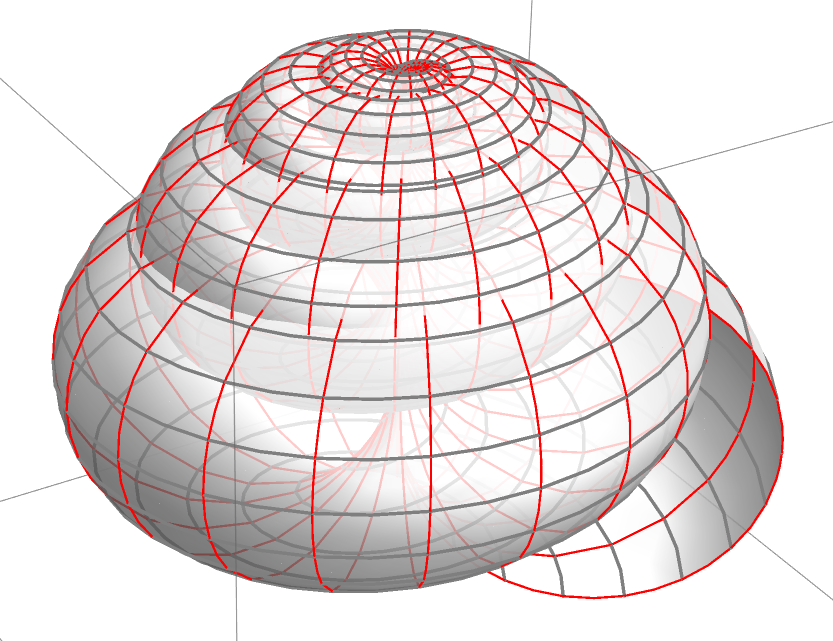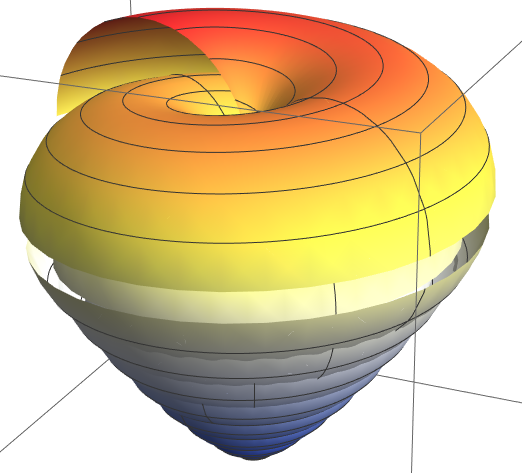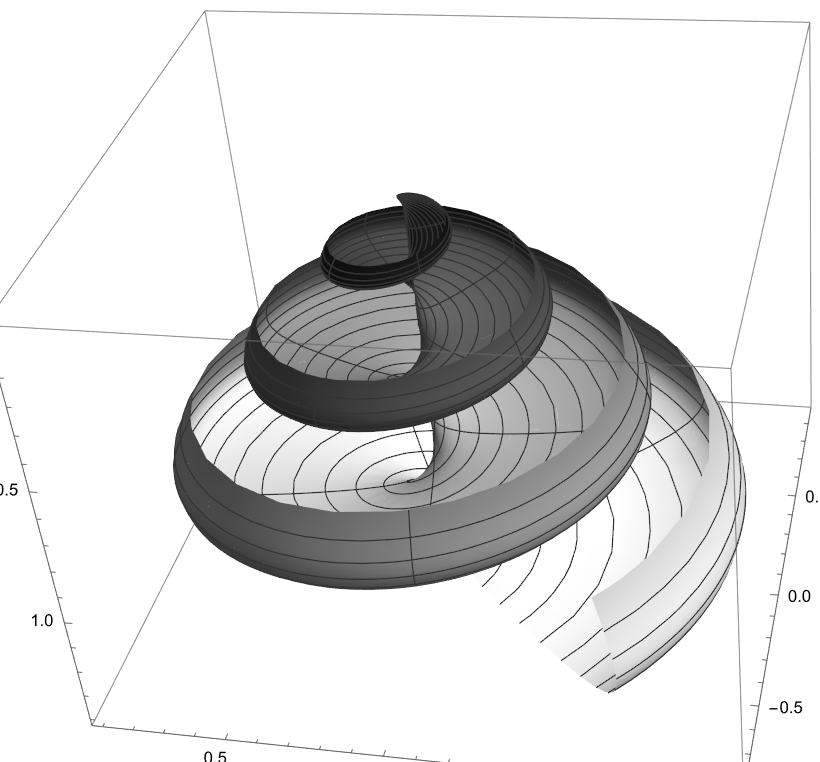Math Parametric Equation for Seashell
The following are some math formulas for seashell, by Mike Willams. (slightly modified)
- From: mike@econym.demon.co.uk
- Subject: Paramnetric equations of seashells
- Date: January 19, 2005 12:35:17 AM PST
- To: xah@xahlee.org
I hear that you're interested in parametric equations that approximate spiral seashells. Here are a few that I've made.
They're all based on this parameterisation of the torus
(* a torus *) R = 1; R2 = 2; ParametricPlot3D[ { R* Cos[u]*(R2+Cos[v]), R*Sin[u]*(R2+Cos[v]), R*Sin[v] }, {u, 0, 6}, {v, 0, 10} ]
I then replaced R with R*u/(2*pi) so that the radius of the tube increases linearly as u increases, and replaced sin(u) with sin(N*u) so that the tube spirals round the origin N times. Then I added an offset factor H*(u/2*pi)^P so that the turns of the spiral are offset in the z direction by a distance that varies from 0 to H.
This gives a periwinkle seashell:
periwinkle seashell

xR = 1; (*radius of tube*) xturnN = 4.6; (*number of turns*) xhei = 2; (*height*) xPower = 2; (*power*) xf = Function[x, x/(2*Pi)*xR]; ParametricPlot3D[{xf[u]*Cos[xturnN*u]*(1 + Cos[v]), xf[u]*Sin[xturnN*u]*(1 + Cos[v]), xf[u]*Sin[v] + xhei*(u/(2*Pi))^xPower}, {u, 0, 2 Pi}, {v, 0, 2 Pi}, PlotRange -> All, ColorFunction -> Black,(*MeshShading->{{None},{None}},*)Mesh -> Full, MeshStyle -> {{Red, Thickness[0.002]}, {Gray, Thickness[0.003]}}, PlotStyle -> Directive[White, Opacity[.8], Specularity[1, 9]], PlotPoints -> {90, 20}]
top shell
And a top

R=1; (* radius of tube *) cN=7.6; (* number of turns *) H=2.5; (* height *) P=1.3; (* power *) W = Function[ {u}, u/(2*Pi)*R ]; ParametricPlot3D[ {W[u]*Cos[cN*u]*(1+Cos[v]), W[u]*Sin[cN*u]*(1+Cos[v]), W[u]*Sin[v] + H*(u/(2*Pi))^P }, {u,0,7}, {v,0,6}, PlotPoints -> {160, 10}, PlotRange -> All, ColorFunction -> "TemperatureMap" ]
cone shell
A cone shell is something like this:
A cone shell is something like this: R=1; // radius of tube N=4.6; // number of turns H=0.5; // height P=2; // power W = u/(2*pi)*R Fx = W(u)*cos(N*u)*(1+cos(v)) Fy = W(u)*sin(N*u)*(1+cos(v)) Fz = W(u)*sin(v)*1.25 + H*(u/(2*pi))^P +W(u)*cos(v)*1.25
-- Mike Williams Gentleman of Leisure
From: private@econym.demon.co.uk Subject: Parametric equations of seashells Date: January 20, 2005 9:41:46 PM PST To: xah@xahlee.org
You wrote
hi Mike,
Great work!
of your results, i find the wrinkled version of greatest interest. Now it would be great if one can add to the equation periodic spikes, as to make one of those horny ones,
I reckon that this general approach would only be able to place spikes that point in the +-x and +-y directions. This might make something that at first glance resembles a Venus Comb, but the rows of spikes should really point in directions separated by about 120 degrees rather than 90.
For spikes that point in other directions I think you'd need an entirely different approach.
I think the ideal “top” one should have a flat surface, very angular triangular opening, and with a cone shaped hole at the bottom. See * Seashell Gallery: Top Shell
We only have one species of “top” in my country (Britain), the “Toothed Topshell” (Monodonta lineata) and it is quite rounded. A flat sided topshell is more like this:
R=1; // radius of tube N=7.6; // number of turns H=2.5; // height P=1.3; // power T=0.8; // Triangleness of cross section A=-0.3; // Angle of tilt of cross section (radians) W = u/(2*pi)*R Fx = W(u)*cos(N*u)*(1+cos(v+A)+sin(2*v+A)*T/4) Fy = W(u)*sin(N*u)*(1+cos(v+A)+sin(2*v+A)*T/4) Fz = W(u)*(sin(v+A)+cos(2*v+A)*T/4) + H*(u/(2*pi))^P
Which also gives the possibility of creating something like a turret shell (oddly, my book of British fauna doesn't include these, but there's loads of them on the local beach). I can't quite seem to get the coils to touch each other correctly at the tip.
R=1; // radius of tube N=9.6; // number of turns H=5.0; // height P=1.5; // power P1=1.1; // another power T=0.8; // Triangleness of cross section A=0.1; // Angle of tilt of cross section (radians) S=1.5; // Stretch W = (u/(2*pi)*R)^P1 Fx = W(u)*cos(N*u)*(1+cos(v+A)+sin(2*v+A)*T/4) Fy = W(u)*sin(N*u)*(1+cos(v+A)+sin(2*v+A)*T/4) Fz = S*W(u)*(sin(v+A)+cos(2*v+A)*T/4) + S*H*(u/(2*pi))^P
Whilst trying to get the turret working, I happened to create this by mistake.
R=1; // radius of tube N=7.6; // number of turns H=2.5; // height P=1.3; // power T=0.8; // Triangleness of cross section A=-0.3; // Angle of tilt of cross section (radians) S=3.0; // Stretch W = u/(2*pi)*R Fx = W(u)*cos(N*u)*(1+cos(v+A)+sin(2*v+A)*T/4) Fy = W(u)*sin(N*u)*(1+cos(v+A)+sin(2*v+A)*T/4) Fz = S*W(u)*(sin(v+A)+cos(2*v+A)*T/4) + S*H*(u/(2*pi))^P
I should have mentioned (but I guess you've worked it out for yourself) that all these surfaces are designed to be generated with u and v both being in the range 0 to 2*pi.
PS may i forward your results to the curves-surfaces mailing list?
Yes.
Is there an actual mailing list? All I could find at the URL you gave me was one of those horrible Google Groups.
-- Mike Williams Gentleman of Leisure
spindle shell
R=1; // radius of tube N=5.6; // number of turns H=4.5; // height P=1.4; // power L=4; // Controls spike length K=9; // Controls spike sharpness W = (u/(2*pi)*R)^0.9 Fx = W(u)*cos(N*u)*(1+cos(v)) Fy = W(u)*sin(N*u)*(1+cos(v)) Fz = W(u)*(sin(v)+L*(sin(v/2))^K) + H*(u/(2*pi))^P
top shell

(* radius of tube *) tubeRadius = 1; (* number of turns *) turns = 7.6; height = 2.5; powerP = 1.3; (* Triangleness of cross section *) triangleX = 0.8; (* crossTiltngle of tilt of cross section (radians) *) crossTilt = -0.3; ff = Function[x, (x/(2*Pi)* tubeRadius)]; ParametricPlot3D[ { ff[u]*Cos[turns*u]*(1+Cos[v+crossTilt]+Sin[2*v+crossTilt]*triangleX/4), ff[u]*Sin[turns*u]*(1+Cos[v+crossTilt]+Sin[2*v+crossTilt]*triangleX/4), ff[u]*(Sin[v+crossTilt]+Cos[2*v+crossTilt]*triangleX/4) + height*(u/(2*Pi))^powerP }, {u,0,3}, {v,0,3}, ColorFunction -> GrayLevel, PlotPoints -> {90, 10} ]
back to Math of Seashell Shapes